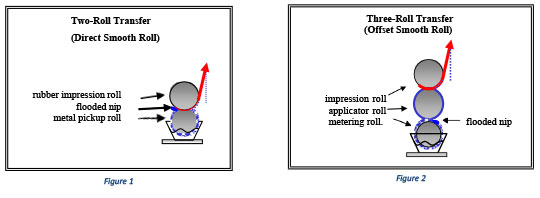Primer application is not limited to gravure systems. Many converters have found that smooth roll applicators are also well-suited to apply MICA water-based primers. A smooth roll applicator effectively delivers thin coat weights of low viscosity primers, such as MICA A-131-X. Compared to gravure coating, the smooth roll system uses the same rolls for every job. The impression roll does not need to be undercut, and therefore the applicator can accommodate varying web widths. Smooth roll applicators are less likely to entrain air (and generate foam) because, unlike gravure, there are no empty cells returning to the primer pan. Cleanup is simplified because there are no cells prone to plugging. This document is meant to provide some guidance, tips, and best practices for applying primer with, and selecting, a smooth roll applicator.
Keys to Successful Smooth Roll Application
Smooth Roll Selection
The choice of rubber, hardness of the impression roll, and nip pressure are important factors that can affect coat weight. Here are some basic guidelines and facts about smooth roll selection.
- A smooth roll is chrome plated with a typical surface roughness range of Ra = 1.6-3.0
- Nitrile butadiene rubber (NBR), Hypalon and silicon rubber are some typical types of rubber used in coated impression rollers.
- Roll hardness should be around 70-75 Shore A or 75-90 Shore A for wider rolls (>43”, 1100mm).
- Wider rolls require crowning to avoid a gap at the center when pressure is applied on both ends.
- Some systems have micrometer gap spacing instruments that can be used to compensate for various substrate thicknesses. This type of adjustment is very helpful when switching between paperboard types.
- The coating weight is determined by the pressure applied by air cylinders at both edges of the shaft and the type of rubber and hardness used.
- The surface of the rubber impression roller and air cylinders must be properly maintained to give an even distribution of primer across the web.
Priming Preparation
Here are some best practices we have compiled over the years to help you improve performance and ensure success when using a smooth roll applicator to apply MICA primers.
- General Guidelines:
- The primer pan should be deep enough to cover approximately 50% of the radius of the pickup roll.
- The primer solids content can be diluted to obtain the proper primer wet delivery rate.
- Maintain an adequate flood at the nip, and never starve the system.
- A circulation pump should be used to ensure there is enough primer in the pan to maintain a flooded nip.
- The primer pan size should be kept to a minimum to avoid wasting too much primer at the end of a job.
- Ensuring a Uniform Coating and Avoid Backside Coating:
- Select an impression roll using the guidelines provided in the “Smooth Roll Selection” section above.
- Vary the nip compression.
- Vary the speed and/or direction of the pickup roll.
- Achieving High Line Speeds and Reducing Slinging:
Increasing line speeds without taking the proper precautions could lead to bowed rolls, uneven application, or slinging. Use these guidelines to safely achieve high line speeds and reduce slinging.
- Increase the roll diameter prior to increasing line speeds to prevent bowed rolls which can result in uneven application.
- Reduce pickup roll (direct- Figure 1) or metering roll (offset- Figure 2) speed relative to line speed.
- Employ splash guards at roll ends.
- The impression roll should be the same width as the chrome roll for easier clean-up.
- For speeds over 250 m/min a closed doctor blade chamber can be employed to avoid primer splashing.

For more information please visit our website www.packone.in
